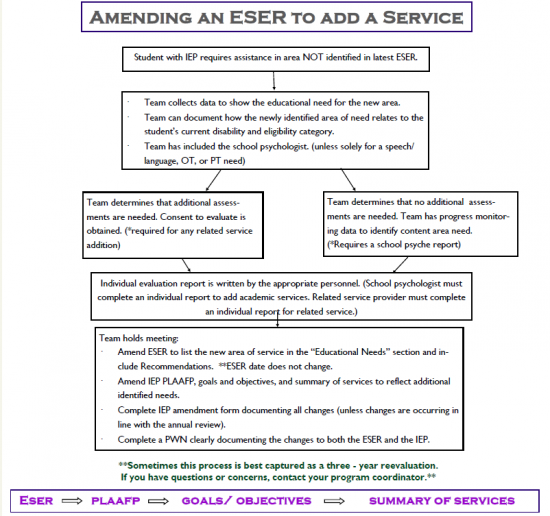The PLAAFP, Summary of Services, and Goals and Objectives must be aligned with the needs and recommendations outlined in the ESER. (The State Compliance Monitors identified this as an area we need to address).
 If the student has need of adding any SPED service that is not yet documented in the ESER, then the student must be evaluated specifically for that need/service. The student’s needs and recommendations from the evaluation may then be added to the ESER. This applies to all areas of service.
If the student has need of adding any SPED service that is not yet documented in the ESER, then the student must be evaluated specifically for that need/service. The student’s needs and recommendations from the evaluation may then be added to the ESER. This applies to all areas of service.
Examples:
 A student cannot have only articulation/language needs and recommendations within the ESER and receive any other SPED services in the IEP
A student cannot have only articulation/language needs and recommendations within the ESER and receive any other SPED services in the IEP
 A student cannot have only math needs and recommendations within the ESER and receive services in the IEP, for reading, writing, articulation/language, OT or other SPED services
A student cannot have only math needs and recommendations within the ESER and receive services in the IEP, for reading, writing, articulation/language, OT or other SPED services
 A student qualified for special education in writing and the needs/recommendations section of the ESER only addresses writing, you cannot write goals and objective in areas outside of writing.
A student qualified for special education in writing and the needs/recommendations section of the ESER only addresses writing, you cannot write goals and objective in areas outside of writing.
If there is a need to add services but not change the eligibility category at this time:
 The team must collect the data to show the education need for the service.
The team must collect the data to show the education need for the service.
 A permission to test is needed if new assessments are required
A permission to test is needed if new assessments are required
 A permission to test would not be needed if looking at progress monitoring data that has been collected (note, we cannot add related services using only progress monitoring data)
A permission to test would not be needed if looking at progress monitoring data that has been collected (note, we cannot add related services using only progress monitoring data)
 The team will hold an IEP Amendment Meeting (unless this additional falls in line with an annual review) and amend the ESER to include a new individual evaluation report that addresses the educational need for the new service. **It would be best practice to hold a meeting rather than using the “without meeting” option of the amendment.
The team will hold an IEP Amendment Meeting (unless this additional falls in line with an annual review) and amend the ESER to include a new individual evaluation report that addresses the educational need for the new service. **It would be best practice to hold a meeting rather than using the “without meeting” option of the amendment.
* The amended ESER will list the new area of service(s) in the “Education Needs” section. **The team will NOT change the ESER date.
* The ESER and the PLAAFP will include all areas of needs that are on the Summary of Services.
* Goals and objectives will be written to address the new area of service.
* An IEP amendment form will be completed with a change noted in goals/objectives and in type/or amount of service.
* The changes will be documented on a PWN. The changes to both the ESER and the IEP can be documented in a single PWN as long as all changes are clear for both areas.
![]() Change a student’s eligibility category – this requires a complete evaluation.
Change a student’s eligibility category – this requires a complete evaluation.![]() Remove a related service – we do not reverse what has already been identified as a need.
Remove a related service – we do not reverse what has already been identified as a need.![]() Remove an educational need or change a recommendation. The IEP is the fluid document that describes the student’s current level of functioning.
Remove an educational need or change a recommendation. The IEP is the fluid document that describes the student’s current level of functioning.
